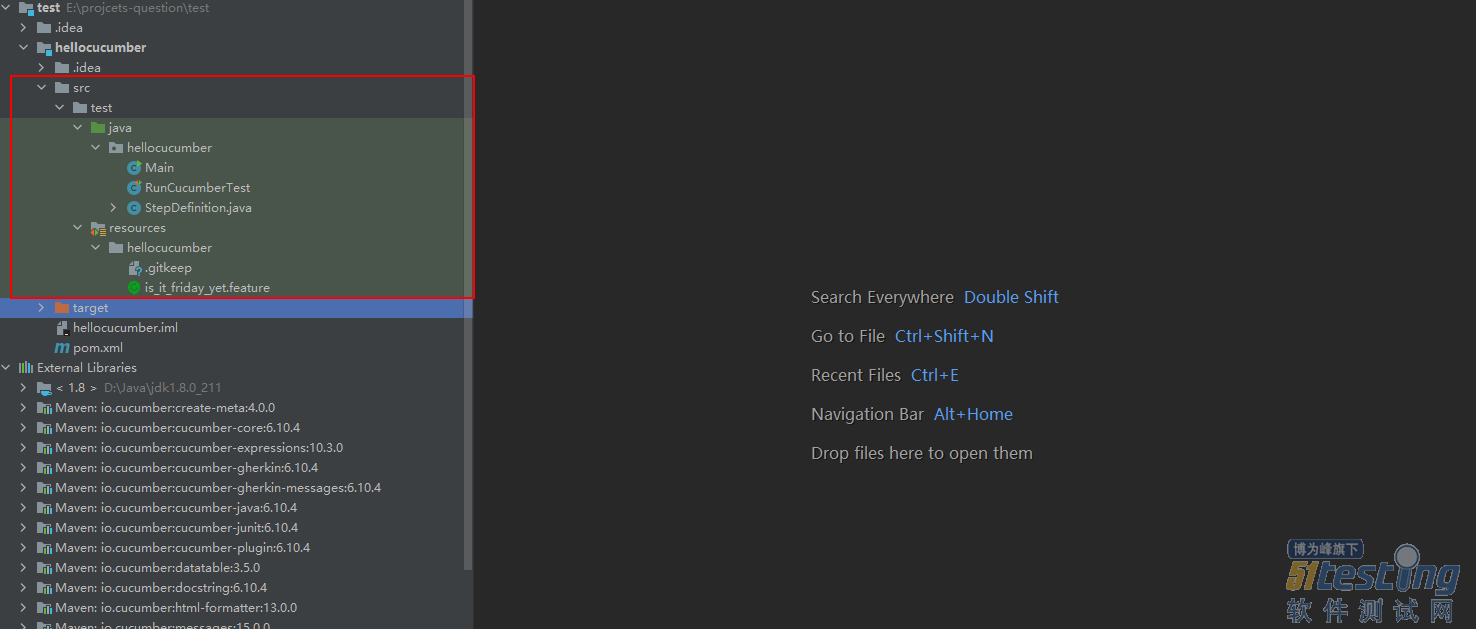- 自动化测试工具Cucumber的简单介绍——软件测试圈
背景介绍
随着测试的发展,测试自动化越来越成为人们的关注点。
现在我们公司也在进行接口自动化的推广,在我看来接口自动化的价值就在于整体项目的回归,完成一些没法通过人力进行的测试,比如压力测试。
为了解决测试开发人员和功能测试人员的同步问题,选择了Cucumber框架。
Cucumber是一个能够理解用普通语言描述测试用例的行为驱动开发(BDD)的自动化测试工具。
换句话说就是学习成本比较低,并且可以方便测试开发人员和功能测试人员协同合作、开发人员进行公共方法的封装、功能测试人员进行测试用例的编写。
Cucumber组成
由Features、Step_definitions、Cucumber command组成。
Features
·基于Gherkin,支持语言:# language: en (zh-CN)等;
·Features文件必须以.features命名;
·包含title,多个scenarios,每个scenario包含多个step。
示例如下:多组参数传参。
``` Features: test //Features关键字,测试用例集 Scenario Outline: eating //Scenario Outline关键字,测数用例 Given there are <start> cucumbers //Given关键字,进行接口请求 When I eat <eat> cucumbers //When关键字,数据准备 Then I should have <left> cucumbers //Then关键字 Examples: | start | eat | left | | 12 | 5 | 7 | | 20 | 5 | 15 | ```
关键字详解:
Feature (功能):test suite (测试用例集)。
Scenario(情景):test case (测试用例)。
Scenario Outline (or Scenario Template):和examples更配。
Given(给定:setup(创建测试所需环境)。
When(当):test(触发被测事件)。
Then(则):assert(断言,验证结果)。
Background(背景):您会发现自己在一个功能的所有场景中重复相同的给定步骤,因为它在每个场景中都是重复的。
这表明这些步骤对于描述场景不是必需的,它们是附带的细节。您可以通过将这些给定的步骤分组到background部分,将它们移动到后台。
And(or But):如果你有连续的“给定”、“何时”或“然后”。
"""(定义多行字符串):方便地将较大的文本段传递给步骤定义。
|(用来定义表格):数据表便于将值列表传递给步骤定义。
Step_definitions
Step定义必须以关键字Given、When、Then、And开始,根据正则匹配对应的关键字。
根据feature文件中定义的step编写对应的测试代码。
示例如下:
```java
public class StepDefinition {
private String today;
private String actualAnswer;
@Given("^today is Sunday$") //和features中的Given对应
public void today_is_Sunday() {
today = "Sunday";
}
@When("^I ask whether it's Friday yet$") //和features中的When对应
public void i_ask_whether_is_s_Friday_yet() {
actualAnswer = IsItFriday.isItFriday(today);
}
@Then("^I should be told \"([^\"]*)\"$") //和features中的Then对应
public void i_should_be_told(String expectedAnswer) {
assertEquals(expectedAnswer, actualAnswer);
}
}
```Cucumber command
运行*.feature文件,Cucumber会分析feature文件中定义的step,然后去step -definitions寻找相匹配的step,执行step中的代码。
运行结果以html的形式保存,fail的情况查看对应log日志。
Cucumber开发过程
1.首先使用Cucumber原型Maven插件创建一个新的项目目录。
```powershell mvn archetype:generate -DarchetypeGroupId=io.cucumber -DarchetypeArtifactId=cucumber-archetype -DarchetypeVersion=6.10.4 -DgroupId=hellocucumber -DartifactId=hellocucumber -Dpackage=hellocucumber -Dversion=1.0.0-SNAPSHOT -DinteractiveMode=false ```
项目目录如下:

2、在reources文件夹下,创建feature文件,包括feature、scenarios和step。
``` Feature: Is it Friday yet? //Features关键字,测试用例集 Scenario: Sunday isn't Friday //Scenario Outline关键字,测试用例 Given today is Sunday //Given关键字,进行接口请求 When I ask whether it's Friday yet //When关键字,数据准备 Then I should be told "Nope" //Then关键字 ```
3.在hellocucumber文件下创建step_definitions。
```java
package hellocucumber;
import io.cucumber.java.en.Given;
import io.cucumber.java.en.Then;
import io.cucumber.java.en.When;
import static org.junit.Assert.*;
class IsItFriday {
static String isItFriday(String today) {
return "Nope";
}
}
public class StepDefinition {
private String today;
private String actualAnswer;
@Given("^today is Sunday$") //和features中的Given对应
public void today_is_Sunday() {
today = "Sunday";
}
@When("^I ask whether it's Friday yet$") //和features中的When对应
public void i_ask_whether_is_s_Friday_yet() {
actualAnswer = IsItFriday.isItFriday(today);
}
@Then("^I should be told \"([^\"]*)\"$") //和features中的Then对应
public void i_should_be_told(String expectedAnswer) {
assertEquals(expectedAnswer, actualAnswer);
}
}
```4.项目运行,在idea中直接运行hellocucumber文件夹下的Runcucumber.java文件即可。
```java
import io.cucumber.junit.Cucumber;
import io.cucumber.junit.CucumberOptions;
import org.junit.runner.RunWith;
@RunWith(Cucumber.class)
@CucumberOptions(plugin = {"pretty"})
public class RunCucumberTest {
}
```测试用例设计
测试用例设计时按接口文档给的标准生成数据,然后填充到如下图的examples中即可,框架会循环进行执行测试用例,生成测试结果。
``` Features: test //Features关键字,测试用例集 Scenario Outline: eating //Scenario Outline关键字,测试用例 Given there are <start> cucumbers //Given关键字,进行接口请求 When I eat <eat> cucumbers //When关键字,数据准备 Then I should have <left> cucumbers //Then关键字 Examples: //Examples关键字 | start | eat | left | | 12 | 5 | 7 | | 20 | 5 | 15 | ```
后期维护
后续迭代版本功能测试人员和测试开发人员分工进行,功能测试人员维护Features,也就是测试用例。
测试开发人员进行step_definitions的维护,就是一些代码逻辑和公共方法,最重要的也就是断言方法的改动比较大,接口请求就几乎是格式化的东西。
项目框架定制思路
1.测试前数据准备:类似于登录后获取请求头这种在里面进行实现。
2.测试用例数据:Features文件中存放。
3.逻辑处理,接口请求:封装到Step_definitions。
4.公共工具封装:一些数据库连接,yaml文件读取或者一些其他工具的存放地点。
5.框架配置信息:环境相关信息放置位置,不同城市、不同数据库、不同账号的切换在里面进行设置。
6.测试报告存放位置:用于测试报告的存放,接口文档的存放。
作者:恋空
来源:http://www.51testing.com/html/28/n-4478928.html
- 0.00 查看剩余0%
- 【留下美好印记】赞赏支持
- 推荐阅读
- 换一换
- 测试圈内卷之谁也别想好!——软件测试圈09-29内卷不仅仅是技术和年龄,还有地理位置。有句俗话说的好:万物皆可卷。 但不管是用煎饼还是资源,内卷充斥在方方面面的时候,被裹挟在其中的人不管是随波逐流还是身不由己,都没法置身事外,都会或多或少受到这样那样的影响。 在没有增量资源的情况下,整个社会对存量资源争夺而加剧,这样的趋势在短期内暂时还没有看到缓解的迹象。 内卷是恶性竞争 内卷当然跟竞争有关,但是也不是所有的竞争都是内卷。良性的竞争,可以让参与竞争的各方最后都得到好处,同时还能实现总体发展。 所以,内卷首先的一个表现就是恶性竞争。 一线内卷 当我们说过了从技术和年龄角度的内卷,那就要提一下另一个角度的内卷:一线。 这个一...
- 沟通BUG的礼仪03-19报BUG的礼仪前段时间网络流传很广泛的测试人员报BUG的礼仪:中国国遵守的是礼尚往来,测试人员遵守礼仪,也希望开发同学以礼相待。在和测试人员沟通BUG时,下面的雷千万别踩。沟通BUG的雷区1)你会不会提BUG。和测试人员打交道,千万别说这句话。这句话的杀伤力相当于在东北说:你瞅啥?回答肯定是:提了咋地!我工作这么多年了,怎么不会提BUG?(内心独白)老子混了这么多年了,提BUG还用你教? 之前有个同事Y被程序员Z的指责不会提BUG,Y一气之下,一个上午提了Z十几个BUG,把Z气得找项目经理说别让Y再测了。2)就是这么设计的。如果这样答复测试人员,你最好有实在的证据说明你的理由,否则会...

- 测试一个新功能时,最重要的一个步骤就是编写测试用例,测试用例写好了,那么后面的测试工作基本就非常顺利了,那么作为一个职场新人来说,怎样提高测试用例的质量呢? 充分理解需求 作为一个新人来说,对所做项目并没有太深入的了解,那么拿到测试需求后,不应该拿到什么就是什么,需求上怎么写就怎么做,要有自己的见解。 举个例子来说,某个网站年终大促,要搞个优惠活动,有两种优惠方式: 第一种是店铺自己发的优惠,两件8折、3件7折; 另一种是平台提供的优惠,满100-10、200-30。 测试人员A拿到这个需求后,发现非常简单,迅速的就将测试用例编写完了,如下: 乍一看是没有问题的,所有情况也都...

-
- iPhone 15 已经到来。在今天于库比蒂诺举行的"Wonderlust"发布会上,苹果公司的第 17 代手机如期亮相。这款设备带来了许多熟悉的功能,包括现在全线推出的"灵动岛"打孔。 "灵动岛"提供了许多新功能,包括航空公司的航班信息,今年的 iPhone 外观与之前的 iPhone 14 基本相同,iPhone 15 继续使用 6.1 英寸显示屏,Plus 机型为 6.7 英寸。 除了灵动岛的变化外,iPhone 15 最大的明显升级是改进了相机系统。主摄像头传感器从上一代 iPhone 14 的 1200 万像素提升到...

-
- 测试开发工程师常见面试题——软件测试圈07-29一、功能测试用例的设计举例:(一)我想要回家,让你给我买一张票,然后设计测试用例答案:确定需求(回家回哪,需要什么票,买什么时候的票)开始测试功能测试(我去买票(买火车票,飞机票),买到票(什么时候),回来给你);可靠性测试(我去买票过程中被撞死了,票买不到怎么办,延期了,买那个点的票没了怎么办让我帮他买票的人的身份,比如是否有特殊优待,如军人,1米2以下儿童等,身份证丢了,或者票丢了,责任划分);可维护性测试(票是否可保存完好);兼容性(还不同人的去买,我中间招人去买,我坐车走路);算法测试(我通过不同的渠道买票花费的时间);竞品测试(别的人怎么买的票);安全性测试(身份信息保密);性能测试...
- 关于我们 联系我们 版权声明 广告服务 站长统计
- 建议使用IE 11.0以上浏览器,800×600以上分辨率,法律顾问:上海兰迪律师事务所 项棋律师
- 版权所有 上海博为峰软件技术股份有限公司 Copyright©51testing.com 2003-2024, 沪ICP备05003035号
- 投诉及意见反馈:webmaster@51testing.com; 业务联系:service@51testing.com021-64471599-8017

- 51testing软件测试圈微信


